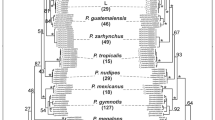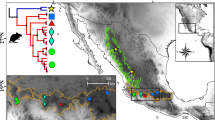Summary
The advent of direct sequencing via the polymerase chain reaction (PCR) has opened up the possibility of molecular studies on museum specimens. Here we analyze genetic variation in populations over time by applying PCR to DNA extracted from museum specimens sampled from populations of one species over the last 78 years. Included in this study were 43 museum specimens of the Panamint kangaroo ratDipodomys panamintinus from localities representing each of three geographically distinct subspecies. These specimens were originally collected and prepared as dried skins in 1911, 1917, or 1937. For each specimen, a 225-bp segment of the mitochondrial genome was sequenced. These mitochondrial DNA sequences were compared to those of 63 specimens collected at the same localities in 1988. The three subspecies were nearly completely distinct. Only 2 of the 106 individuals shared mitochondrial types between subspecies. For all three localities, the diversity levels were maintained between the two temporal samples. The concordance observed between the two temporally separate phylogenies supports the use of museum specimens for phylogenetic inference. This study demonstrates the accuracy and routine nature of the use of museum specimens in the analysis of mitochondrial sequence variation in natural populations and, importantly, that a temporal aspect can now be added to such studies.
Similar content being viewed by others
References
Avise JC, Ball RM, Arnold J (1988) Current versus historical population sizes in vertebrate species with high gene flow: a comparison based on mitochondrial DNA lineages and inbreeding theory for neutral mutations. Mol Biol Evol 5:331–344
Bibb MJ, Van Etten RA, Wright CT, Walberg MW, Clayton DA (1981) Sequence and gene organization of mouse mitochondrial DNA. Cell 26:167–180
Brown GG, Gadaleta G, Pepe G, Saccone C, Sbisà E (1986) Structural conservation and variation in the D-loop-containing region of vertebrate mitochondrial DNA. J Mol Biol 192:503–511
Cabot EL, Beckenbach AT (1989) Simultaneous editing of multiple nucleic acid and protein sequences with ESEE. Comput Appl Biosci 5:233–234
Cann RL, Stoneking M, Wilson AC (1987) Mitochondrial DNA and human evolution. Nature 325:31–36
Dingman RE, Davis RJ, Hunsaker D (1971) Karyotypes of the Panamint kangaroo rat (Dipodomys panamintinus (Merriam)). Experientia 27:1491–1492
Greenberg BD, Newbold JE, Sugino A (1983) Intraspecific nucleotide sequence variability surrounding the origin of replication in human mitochondrial DNA. Gene 21:33–49
Grinnell J (1918) Six new mammals from the Mohave Desert and Inyo regions of California. Univ Calif Publ Zool 17:423–430
Grinnell J (1922) A geographical study of the kangaroo rats of California. Univ Calif Publ Zool 24:1–124
Hall ER (1946) Mammals of Nevada. University of California Press, Berkeley CA
Hall ER (1981) The mammals of North America, ed 2. John Wiley and Sons, New York, p 573
Harrison RG (1988) Animal mitochondrial DNA as a genetic marker in population and evolutionary biology. Trends Ecol Evol 4:6–11
Johnson WE, Selander RK (1971) Protein variation and systematics in kangaroo rats (genusDipodomys). Syst Zool 20:377–405
Jones WT (1987) Dispersal patterns in kangaroo rats (Dipodomys spectabilis). In: Chepko-Sade BD, Harpin ZT (eds) Mammalian dispersal patterns: the effects of social structure on population genetics. University of Chicago Press, Chicago, pp 119–127
Jones WT (1989) Dispersal distance and the range of nightly movements in Merriam's kangaroo rat. J Mammal 70:27–34
Kocher TD, Thomas WK, Meyer A, Edwards SV, Pääbo S, Villablanca FX, Wilson AC (1989) Dynamics of mtDNA evolution in animals: amplification and sequencing with conserved primers. Proc Natl Acad Sci USA 86:6196–6200
McCarten N, Van Devender TR (1988) Late Wisconsin vegetation of robber's roost in the western Mojave Desert, California. Madroño 35:226–237
Merriam CH (1894) Preliminary descriptions of eleven new kangaroo rats of the generaDipodomys andPerodipus. Proc Biol Soc Wash 9:109–116
Nei M, Tajima F (1981) DNA polymorphism detectable by restriction endonucleases. Genetics 97:145–163
Olivo PD, Van de Walle MJ, Laipis PJ, Hauswirth WW (1983) Nucleotide sequence evidence for rapid genotypic shifts in the bovine mitochondrial DNA D-loop. Nature 306:400–402
Pääbo S (1989) Ancient DNA: extraction, characterization, molecular cloning, and enzymatic amplification. Proc Natl Acad Sci USA 86:1939–1943
Pääbo S (1990) Amplifying ancient DNA. In: Innis M, Gelfand D, Sninsky J, White T (eds) PCR protocols: a guide to methods and applications. Academic Press, Orlando FL, pp 159–166
Pääbo S, Wilson AC (1988) Polymerase chain reaction reveals cloning artefacts. Nature 334:387–388
Pääbo S, Gifford JA, Wilson AC (1988) Mitochondrial DNA sequences from a 7000-year old brain. Nucleic Acids Res 16:9775–9787
Pääbo S, Higuchi RG, Wilson AC (1989) Ancient DNA and the polymerase chain reaction. The emerging field of molecular archaeology. J Biol Chem 264:9709–9712
Patton JL, MacArthur H, Yang SY (1976) Systematic relationships of the four-toed populations ofDipodomys heermanni. J Mammal 57:159–163
Roe BA, Ma D-P, Wilson RK, Wong JF-H (1985) The complete nucleotide sequence of theXenopus laevis mitochondrial genome. J Biol Chem 260:9759–9774
Saccone C, Attimonelli M, Sbisà E (1985) Primary and higher order structural analysis of animal mitochondrial DNA. In: Quagliariello E, Slater EC, Palmieri F, Saccone C, Kroon AM (eds) Achievements and perspectives of mitochondrial research, vol II. Elsevier, Amsterdam, pp 37–47
Stock AD (1974) Chromosome evolution in the genusDipodomys and its taxonomic and phylogenetic implications. J Mammal 55:505–526
Swofford DL (1989) PAUP: phylogenetic analysis using parsimony, version 3.0b. Illinois Natural History Survey, Champaign IL
Thomas RH, Schaffner W, Wilson AC, Pääbo S (1989) DNA phylogeny of the extinct marsupial wolf. Nature 340:465–467
White TJ, Arnheim N, Erlich HA (1989) The polymerase chain reaction. Trends Genet 5:185–189
Wilson AC, Cann RL, Carr SM, George M, Gyllensten UB, Helm-Bychowski KM, Higuchi RG, Palumbi SR, Prager EM, Sage RD, Stoneking M (1985) Mitochondrial DNA and two perspectives on evolutionary genetics. Biol J Linn Soc 26:375–400
Yates TL, Barber WR, Armstrong DM (1987) Survey of North American collections of recent mammals. J Mammal [Suppl] 68
Author information
Authors and Affiliations
Rights and permissions
About this article
Cite this article
Thomas, W.K., Pääbo, S., Villablanca, F.X. et al. Spatial and temporal continuity of kangaroo rat populations shown by sequencing mitochondrial DNA from museum specimens. J Mol Evol 31, 101–112 (1990). https://doi.org/10.1007/BF02109479
Received:
Revised:
Accepted:
Issue Date:
DOI: https://doi.org/10.1007/BF02109479




